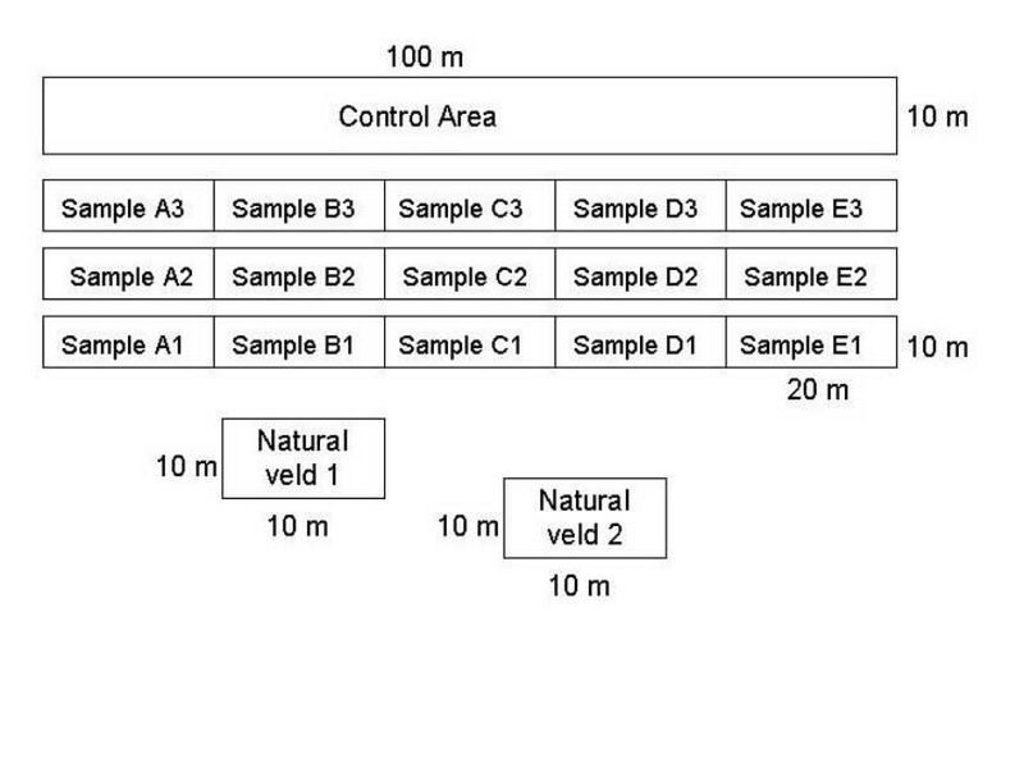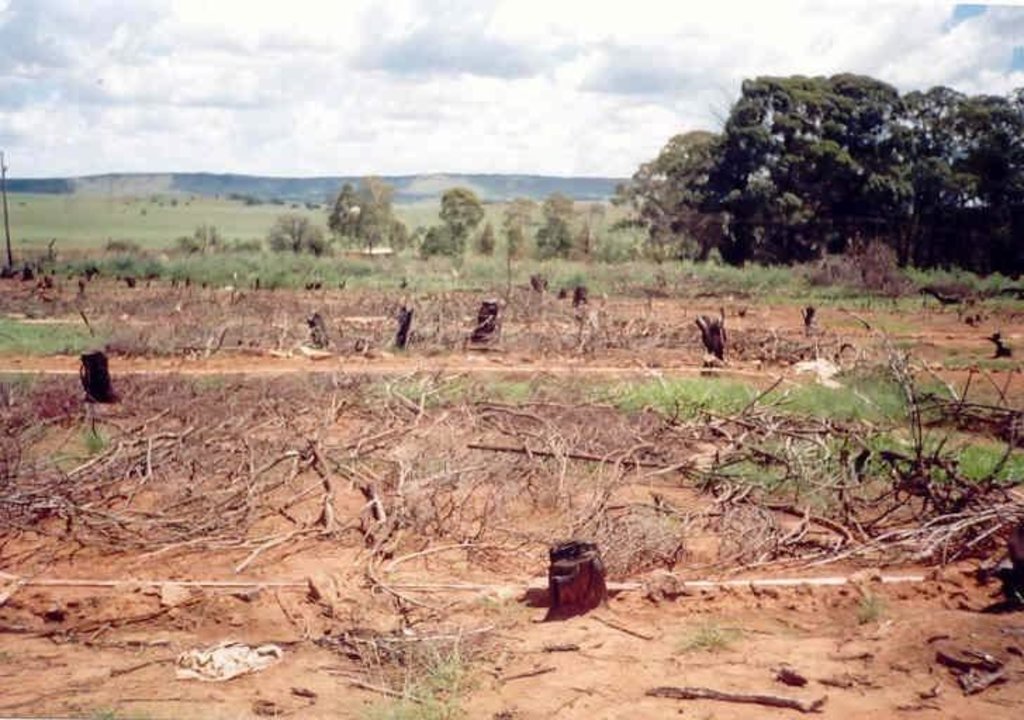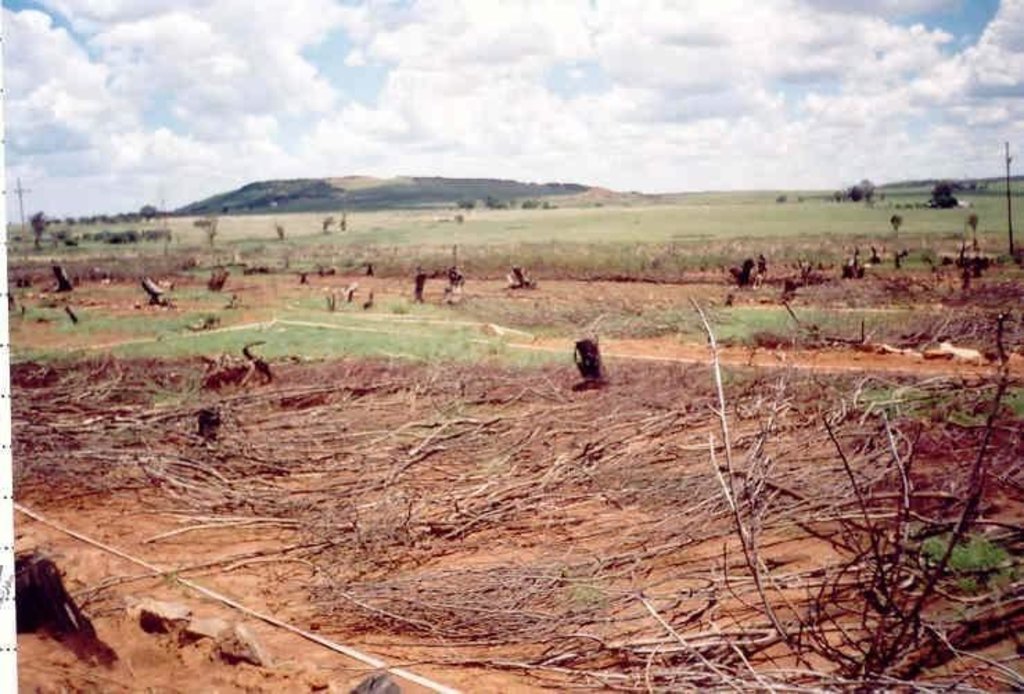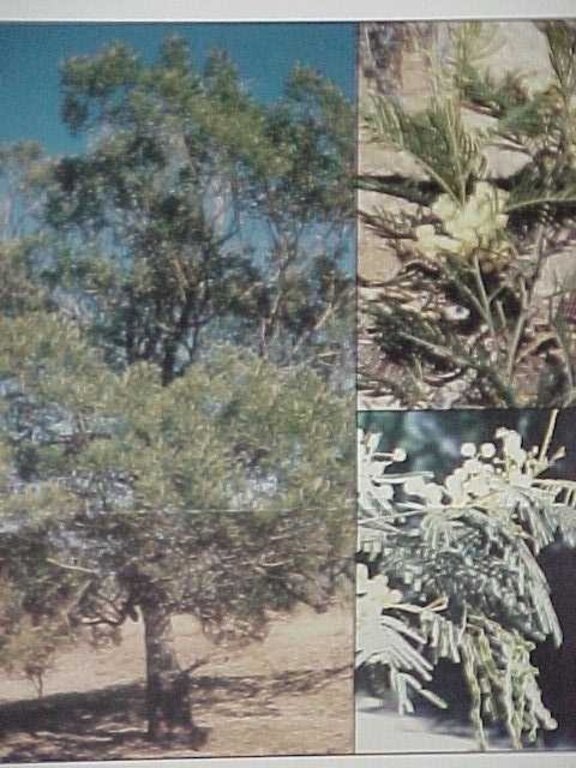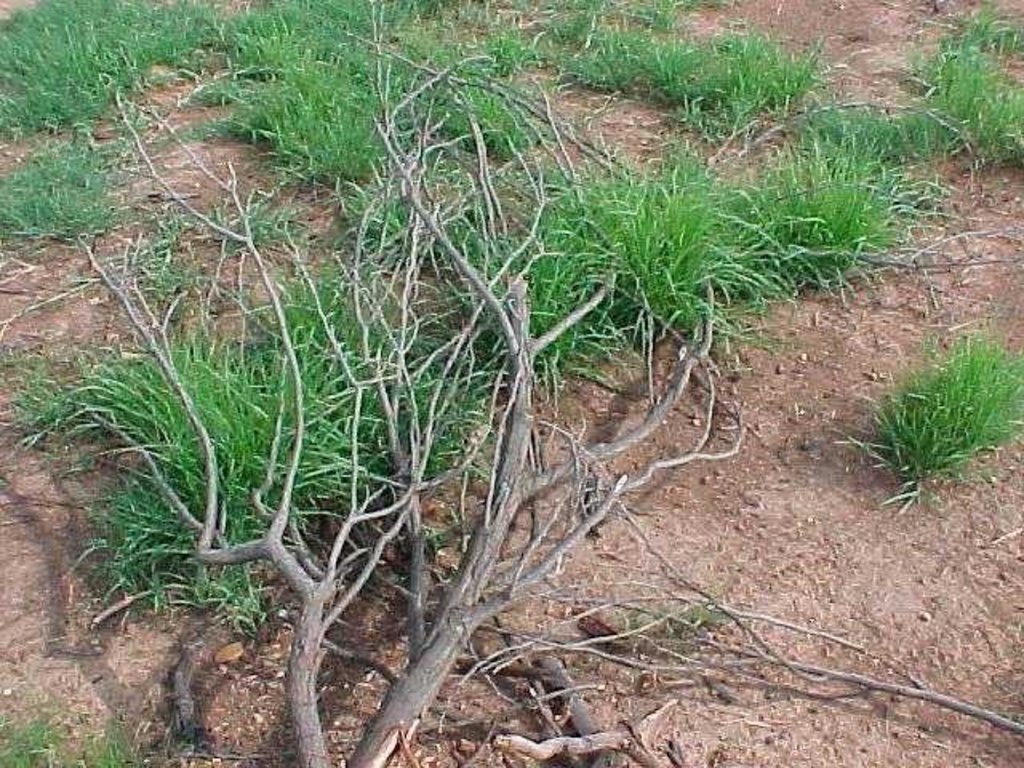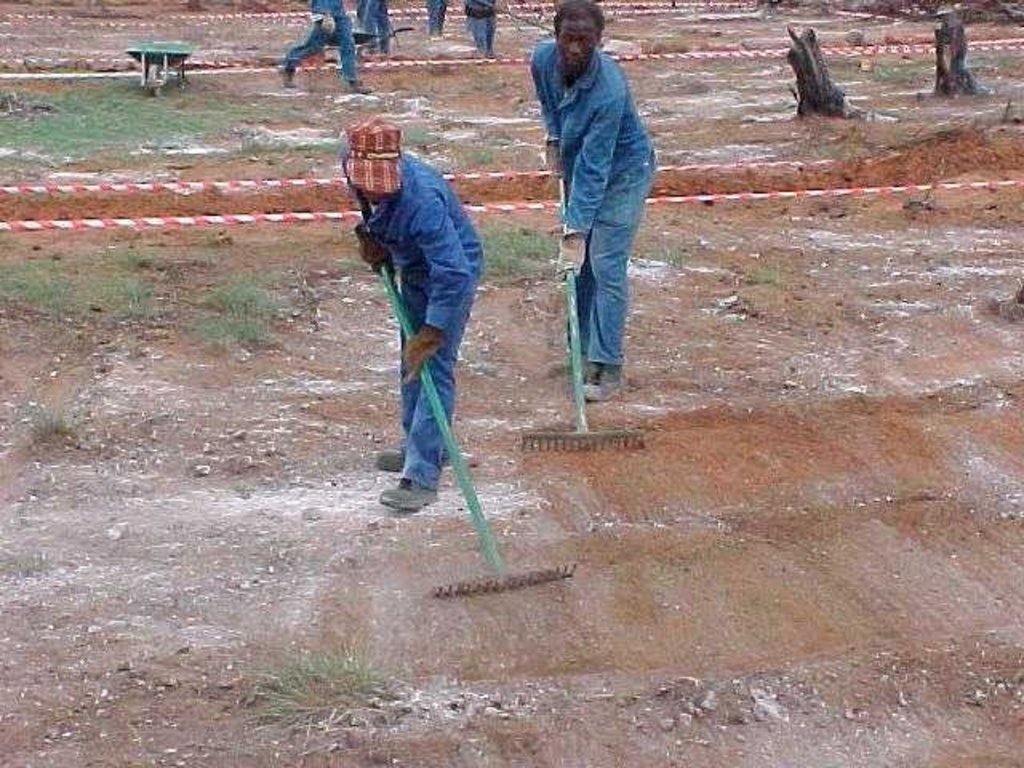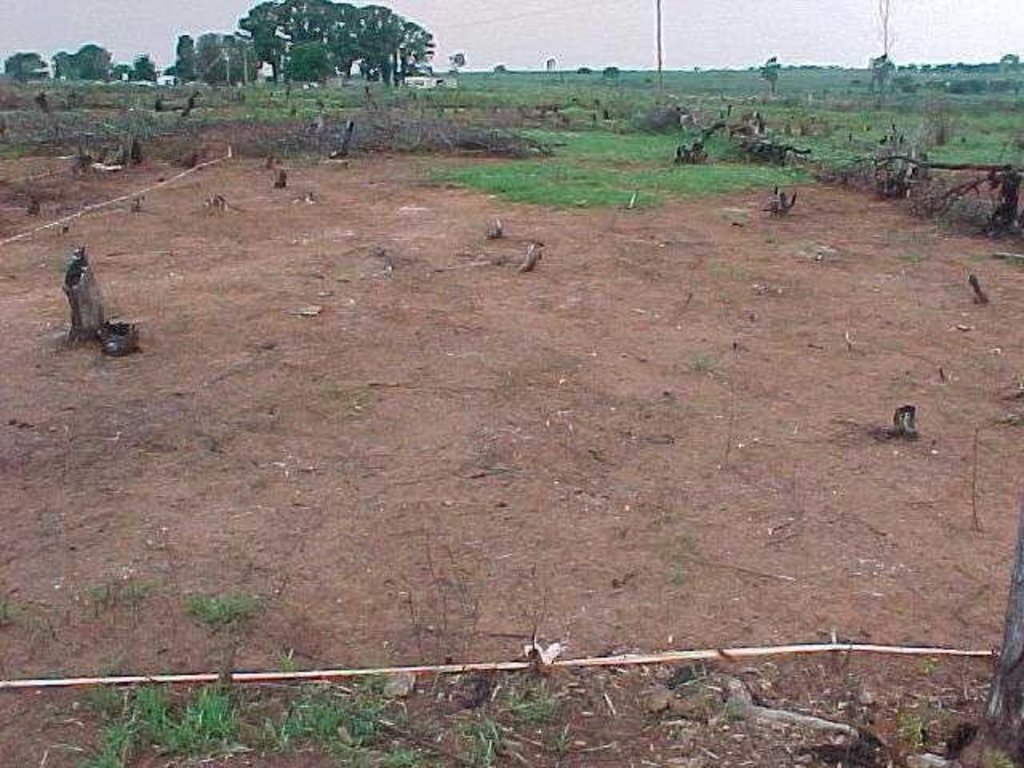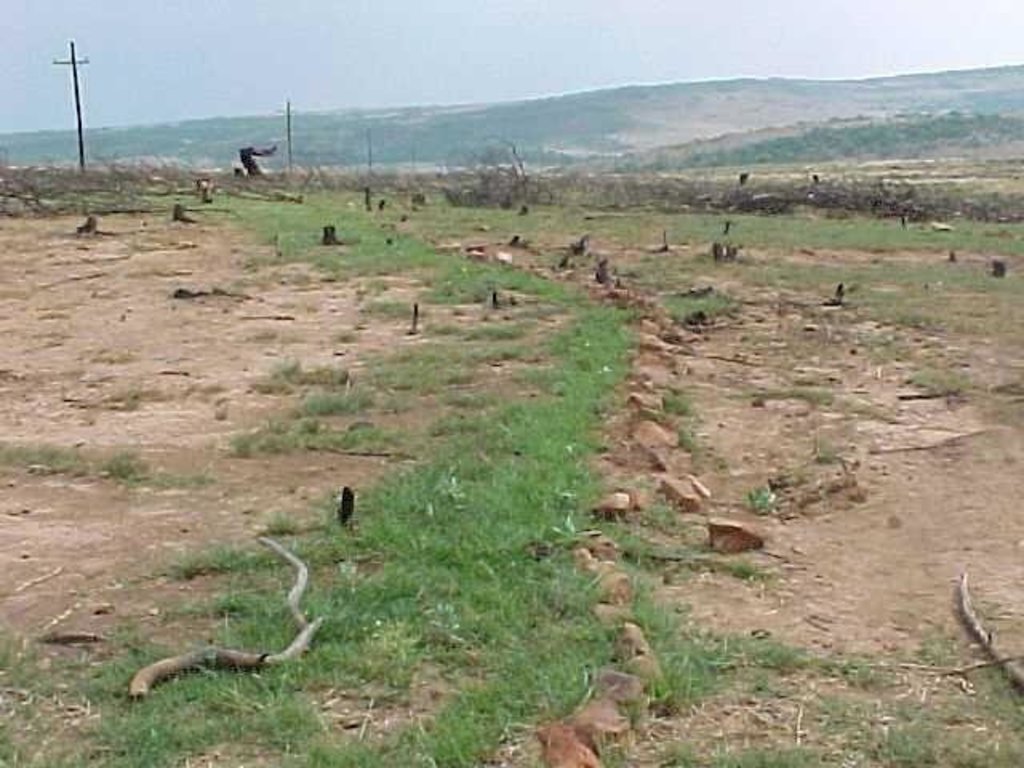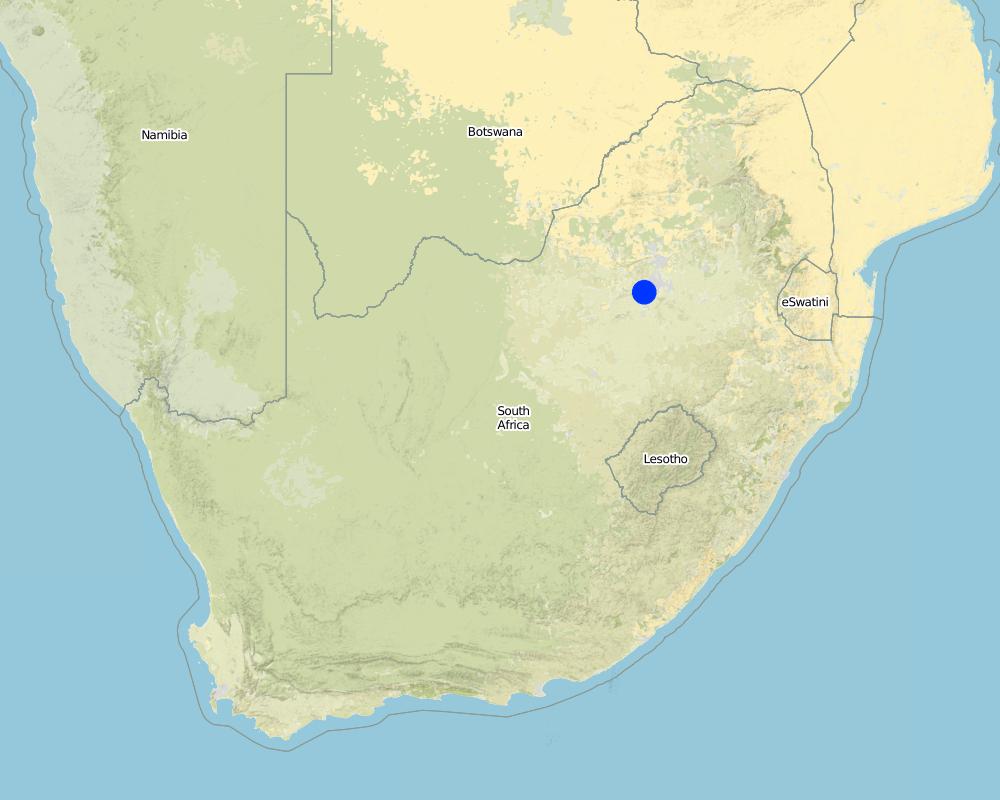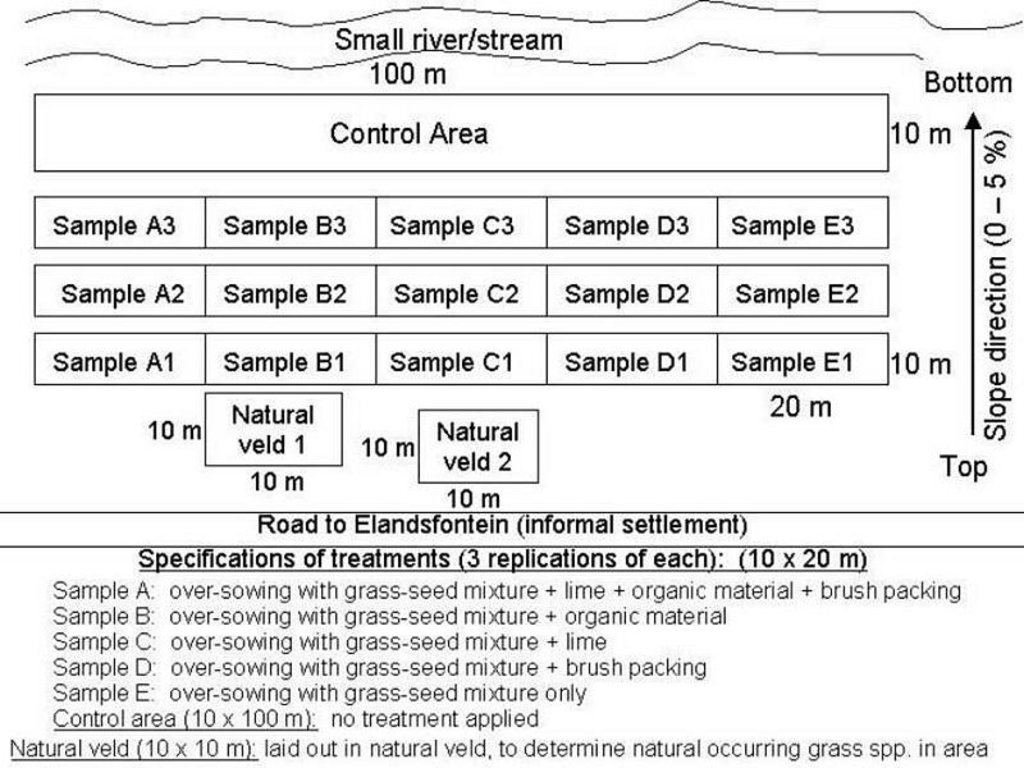Restoration of degraded rangeland [แอฟริกาใต้]
- ผู้สร้างสรรค์:
- การอัพเดท:
- ผู้รวบรวม: Klaus Kellner
- ผู้เรียบเรียง: –
- ผู้ตรวจสอบ: Deborah Niggli, Alexandra Gavilano
Rehabilitation/restoration of an area, after control of alien invasive species.
technologies_1416 - แอฟริกาใต้
ดูส่วนย่อย
ขยายทั้งหมด ย่อทั้งหมด1. ข้อมูลทั่วไป
1.2 รายละเอียดที่ติดต่อได้ของผู้รวบรวมและองค์กรที่เกี่ยวข้องในการประเมินและการจัดเตรียมทำเอกสารของเทคโนโลยี
ผู้เชี่ยวชาญ SLM:
Van Rensburg Leon
แอฟริกาใต้
ผู้เชี่ยวชาญ SLM:
Fulls Erich
แอฟริกาใต้
ชื่อของโครงการซึ่งอำนวยความสะดวกในการทำเอกสารหรือการประเมินเทคโนโลยี (ถ้าเกี่ยวข้อง)
Book project: where the land is greener - Case Studies and Analysis of Soil and Water Conservation Initiatives Worldwide (where the land is greener)ชื่อของโครงการซึ่งอำนวยความสะดวกในการทำเอกสารหรือการประเมินเทคโนโลยี (ถ้าเกี่ยวข้อง)
Sustainable Land Management Practices of South Africa (SLM South Africa)1.3 เงื่อนไขการใช้ข้อมูลที่ได้บันทึกผ่านทาง WOCAT
ผู้รวบรวมและวิทยากรหลักยอมรับเงื่อนไขเกี่ยวกับการใช้ข้อมูลที่ถูกบันทึกผ่านทาง WOCAT:
ใช่
1.4 การเปิดเผยเรื่องความยั่งยืนของเทคโนโลยีที่ได้อธิบายไว้
เทคโนโลยีที่ได้อธิบายไว้นี้เป็นปัญหาของความเสื่อมโทรมโทรมของที่ดินหรือไม่ จึงไม่ได้รับการยอมรับว่าเป็นเทคโนโลยีเพื่อการจัดการที่ดินอย่างยั่งยืน:
ไม่ใช่
2. การอธิบายลักษณะของเทคโนโลยี SLM
2.1 การอธิบายแบบสั้น ๆ ของเทคโนโลยี
คำจำกัดความของเทคโนโลยี:
Eradication of invasive species and revegetation of degraded rangelands by different treatments, including oversowing with grass seed mixture, supplementing with lime, cattle dung, and "brush packing" (laid out branches).
2.2 การอธิบายแบบละเอียดของเทคโนโลยี
คำอธิบาย:
A research investigation was undertaken in an area of degraded communal rangeland, which had been invaded by an alien tree species (Acacia mearnsii – black wattle). Competition from the water-demanding A. mearnsii, combined with overgrazing, had resulted in an almost total absence of palatable grasses. All that was left were a few patches of star grass (or ‘bermuda grass’: Cynodon dactylon). Prior to the research, discussions were held between personnel of the ‘Working for Water’ programme of the South African government and community members.
The purpose of the trials was to determine how best to eradicate the invasive trees and revegetate the rangeland. The restoration area was not fenced off and was thus open to grazing. The trials comprised five treatments, with three replicates each, on plots of 10 m by 20 m. In all treatments the A. mearnsii was eradicated manually, and chemical biocide applied to the stumps to prevent regrowth. Lime and grass seed (of palatable species) were applied to the loosened surface and covered with soil. The five treatments were:
(A) oversowing with grass seed mixture, supplementing of dolomitic lime, cattle dung, and ‘brush packing’ (see below for explanation of term);
(B) oversowing with grass seed mixture and supplementing with cattle dung;
(C) oversowing with grass seed mixture and supplementing with dolomitic lime;
(D) oversowing with grass seed mixture and brush packing;
(E) oversowing with grass seed mixture only.
In addition stone lines were laid out along the contour, between plots. The ‘brush packing’, referred to in treatments A and D comprised branches laid out in strips across the slope to retard runoff, trap soil, improve the micro-climate for establishing grass seedlings and protect the young plants from browsing by animals. The results showed treatment A to be the most effective in restoring the productive and protective function of the rangeland. From the trials, the estimated costs of applying the best technology would be US$ 230 per hectare. The key constraints for successful adoption however are not just technical, but include: (1) the need to protect the area from grazing and trampling by animals during the establishment period; (2) stopping removal of brushwood for firewood; and (3) the need for community agreement on initial protection and subsequent sustainable utilisation of the restored range.
Establishment activities:
1.Manual eradication of trees with chain saw and axe
2.Application of chemical biocide to the stumps to prevent any regrowth
3.Ripping of soil surface to a depth of 5 cm using a three tined hand implement
4.Application of dolomitic lime and raking it into soil after ripping of the soil
5.Application of organic material (cattle dung) after ripping and lime application
6.Oversowing with grass seed mixture after ripping of the soil and application of lime and organic material
7.Brush packing against contour and packing of rock contours against the slope All the branches and stones were collected from the restoration area. Rock contours were packed against (perpendicular) to the slope in the study area at varying intervals (approximately 10-15 m apart) in order to retard runoff water, trap soil, and improve conditions for seed germination (see inserted drawing below and attachment). Branches were packed (brush packing) along the slope in certain treatments within the study site in order to trap soil, retard runoff water en serve as a micro-climate for germinating and establishing grass seedlings
Total duration of restoration took 3 years, from removal of trees till revegetation trials were laid out and technology was established.
Maintenance / recurrent activities per year:
Following initial establishment maintenance was limited to 2 follow up applications of herbicide (after 3 and 5 months). Maintenance of contours was not done after restoration.
2.3 รูปภาพของเทคโนโลยี
2.5 ประเทศภูมิภาค หรือสถานที่ตั้งที่เทคโนโลยีได้นำไปใช้และได้รับการครอบคลุมโดยการประเมินนี้
ประเทศ:
แอฟริกาใต้
ภูมิภาค/รัฐ/จังหวัด:
Gauteng
ข้อมูลจำเพาะเพิ่มเติมของสถานที่ตั้ง :
Johannesburg
ระบุการกระจายตัวของเทคโนโลยี:
- กระจายไปอย่างสม่ำเสมอในพื้นที่
If the Technology is evenly spread over an area, specify area covered (in km2):
9.0
If precise area is not known, indicate approximate area covered:
- 1-10 ตร.กม.
แสดงความคิดเห็น:
Total area covered by the SLM Technology is 9 km2.
Big area near settlement, was previously invaded by alien invasive species (such as A. mearnsii). Aim was to eradicate this species by using chemical/manual methods and to revegetate area with grass species occurring naturally.
Map
×2.6 วันที่การดำเนินการ
ถ้าไม่รู้ปีที่แน่นอน ให้ระบุวันที่โดยประมาณ:
- น้อยกว่า 10 ปี (ไม่นานนี้)
2.7 คำแนะนำของเทคโนโลยี
ให้ระบุว่าเทคโนโลยีถูกแนะนำเข้ามาอย่างไร:
- ในช่วงการทดลองหรือการทำวิจัย
ความคิดเห็น (ประเภทของโครงการ เป็นต้น) :
It originated from the overall need to restore degraded rangelands.
3. การจัดประเภทของเทคโนโลยี SLM
3.1 วัตถุประสงค์หลักของเทคโนโลยี
- ลด ป้องกัน ฟื้นฟู การเสื่อมโทรมของที่ดิน
3.2 ประเภทของการใช้ที่ดินในปัจจุบันที่ได้นำเทคโนโลยีไปใช้

ทุ่งหญ้าเลี้ยงสัตว์
Extensive grazing:
- กึ่งโนแมนดิซึ่มหรือแพสโตแรลลิซึ่ม (Semi-nomadism/pastoralism)
- cattle
แสดงความคิดเห็น:
Major land use problems (compiler’s opinion): Occurrence of bare areas after control of alien invasive.
Major land use problems (land users’ perception): Minimal grazing for cattle, due to the occurrence of bare areas.
Grazingland comments: No area closure, thus livestock graze freely on statelands and thus causes overgrazing over a large area.
This is a constraint to management in grazing lands. No rotational grazing. No area closure, thus livestock graze freely on statelands and thus causes overgrazing over a large area.
Number of growing seasons per year: 1
Longest growing period in days: 210, Longest growing period from month to month: Oct - April
3.4 การใช้น้ำ
การใช้น้ำของที่ดินที่มีการใช้เทคโนโลยีอยู่:
- จากน้ำฝน
3.5 กลุ่ม SLM ที่ตรงกับเทคโนโลยีนี้
- การจัดการปศุสัตว์และทุ่งหญ้าเลี้ยงสัตว์
3.6 มาตรการ SLM ที่ประกอบกันเป็นเทคโนโลยี

มาตรการจัดการพืช
- A7: Others

มาตรการอนุรักษ์ด้วยวิธีพืช
- V5: อื่นๆ

มาตรการอนุรักษ์ด้วยโครงสร้าง
- S11: อื่น ๆ
แสดงความคิดเห็น:
Specification of other agronomic measures: manuring, lime, 'brush packing' (trash lines)
Specification of other vegetative measures: oversowing grass seed mixture
Specification of other structural measures: stone lines
Type of vegetative measures: in blocks
3.7 รูปแบบหลักของการเสื่อมโทรมของที่ดินที่ได้รับการแก้ไขโดยเทคโนโลยี

การกัดกร่อนของดินโดยน้ำ
- Wt (Loss of topsoil): การสูญเสียดินชั้นบนหรือการกัดกร่อนที่ผิวดิน

การเสื่อมโทรมของดินทางด้านเคมี
- Cn (Fertility decline): ความอุดมสมบูรณ์และปริมาณอินทรียวัตถุในดินถูกทำให้ลดลงไป (ไม่ได้เกิดจากสาเหตุการกัดกร่อน)

การเสื่อมโทรมของดินทางด้านกายภาพ
- Pc (Compaction): การอัดแน่น

การเสื่อมโทรมของดินทางด้านชีวภาพ
- Bc (Reduction of vegetation cover): การลดลงของจำนวนพืชที่ปกคลุมดิน
แสดงความคิดเห็น:
Main causes of degradation: deforestation / removal of natural vegetation (incl. forest fires) (Alien invasives.), over-exploitation of vegetation for domestic use (Trampling.), overgrazing (Cattle and goat.)
Secondary causes of degradation: poverty / wealth (Lack of captial - To pay labours to apply technologies.), labour availability (Lack of labour - To remove alien species.)
3.8 การป้องกัน การลดลง หรือการฟื้นฟูความเสื่อมโทรมของที่ดิน
ระบุเป้าหมายของเทคโนโลยีกับความเสื่อมโทรมของที่ดิน:
- ลดความเสื่อมโทรมของดิน
- ฟื้นฟูบำบัดที่ดินที่เสื่อมโทรมลงอย่างมาก
4. ข้อมูลจำเพาะด้านเทคนิค กิจกรรมการนำไปปฏิบัติใช้ ปัจจัยนำเข้า และค่าใช้จ่าย
4.1 แบบแปลนทางเทคนิคของเทคโนโลยี
ข้อมูลจำเพาะด้านเทคนิค (แบบแปลนทางเทคนิคของเทคโนโลยี):
Specifications
Location: Elandsfontein. Gauteng
Technical knowledge required for field staff / advisors: high
Technical knowledge required for land users: moderate
Main technical functions: control of raindrop splash, control of dispersed runoff: retain / trap, increase in organic matter, sediment retention / trapping, sediment harvesting, increase in soil fertility, improvement of ground cover
Secondary technical functions: control of dispersed runoff: impede / retard, reduction of slope angle, increase of surface roughness, increase of infiltration, water harvesting / increase water supply, water spreading, reduction in wind speed, improvement of soil structure
Vegetative measure: contour
Vegetative material: O : other
Number of plants per (ha): 0
Vertical interval between rows / strips / blocks (m): 0.3
Spacing between rows / strips / blocks (m): 3
Vertical interval within rows / strips / blocks (m): 0
Width within rows / strips / blocks (m): 0.3
Vegetative measure: Vegetative material: O : other
Grass species: Mixture of perennial and annual grasses
Other species: rocks
Slope (which determines the spacing indicated above): 5.00%
ผู้เขียน:
Anuschka Barac
4.2 ข้อมูลทั่วไปเกี่ยวกับการคำนวณปัจจัยนำเข้าและค่าใช้จ่าย
อื่นๆ หรือสกุลเงินประจำชาติ (ระบุ):
Rand
If relevant, indicate exchange rate from USD to local currency (e.g. 1 USD = 79.9 Brazilian Real): 1 USD =:
8.2
ระบุค่าเฉลี่ยของค่าจ้างในการจ้างแรงงานต่อวัน:
4.30
4.3 กิจกรรมเพื่อการจัดตั้ง
| กิจกรรม | Timing (season) | |
|---|---|---|
| 1. | Eradication of trees, Follow-up with herbicide | beginning of project |
| 2. | Loosening of soil, Lime application | 6 months |
| 3. | Application of organic material | 6 months |
| 4. | Oversowing with grass seed mixture | 6 months |
| 5. | Brush packing | 6 months |
4.4 ค่าใช้จ่ายของปัจจัยนำเข้าที่จำเป็นสำหรับการจัดตั้ง
| ปัจจัยนำเข้า | หน่วย | ปริมาณ | ค่าใช้จ่ายต่อหน่วย | ค่าใช้จ่ายทั้งหมดต่อปัจจัยนำเข้า | %ของค่าใช้จ่ายที่ก่อให้เกิดขึ้นโดยผู้ใช้ที่ดิน | |
|---|---|---|---|---|---|---|
| แรงงาน | labour | ha | 1.0 | 35.0 | 35.0 | |
| อุปกรณ์ | machine use | ha | 1.0 | 65.0 | 65.0 | |
| อุปกรณ์ | tools | ha | 1.0 | 5.0 | 5.0 | |
| วัสดุด้านพืช | seeds | ha | 1.0 | 70.0 | 70.0 | |
| ปุ๋ยและสารฆ่า/ยับยั้งการเจริญเติบโตของสิ่งมีชีวิต (ไบโอไซด์) | fertilizer | ha | 1.0 | 25.0 | 25.0 | |
| ปุ๋ยและสารฆ่า/ยับยั้งการเจริญเติบโตของสิ่งมีชีวิต (ไบโอไซด์) | biocides | ha | 1.0 | 30.0 | 30.0 | |
| ค่าใช้จ่ายทั้งหมดของการจัดตั้งเทคโนโลยี | 230.0 | |||||
| Total costs for establishment of the Technology in USD | 28.05 | |||||
แสดงความคิดเห็น:
Duration of establishment phase: 35 month(s)
4.5 การบำรุงรักษาสภาพหรือกิจกรรมที่เกิดขึ้นเป็นประจำ
| กิจกรรม | ช่วงระยะเวลา/ความถี่ | |
|---|---|---|
| 1. | 2 Follow-ups with herbicide | after 3 & 5 months after application of technology /twice (at 3 and 5 months ) |
4.6 ค่าใช้จ่ายของปัจจัยนำเข้าและกิจกรรมที่เกิดขึ้นเป็นประจำที่ต้องการการบำรุงรักษา (ต่อปี)
| ปัจจัยนำเข้า | หน่วย | ปริมาณ | ค่าใช้จ่ายต่อหน่วย | ค่าใช้จ่ายทั้งหมดต่อปัจจัยนำเข้า | %ของค่าใช้จ่ายที่ก่อให้เกิดขึ้นโดยผู้ใช้ที่ดิน | |
|---|---|---|---|---|---|---|
| แรงงาน | labour | ha | 1.0 | 7.0 | 7.0 | |
| อุปกรณ์ | tools | ha | 1.0 | 5.0 | 5.0 | |
| ปุ๋ยและสารฆ่า/ยับยั้งการเจริญเติบโตของสิ่งมีชีวิต (ไบโอไซด์) | biocides | ha | 1.0 | 20.0 | 20.0 | |
| ค่าใช้จ่ายทั้งหมดของการบำรุงรักษาสภาพเทคโนโลยี | 32.0 | |||||
| Total costs for maintenance of the Technology in USD | 3.9 | |||||
แสดงความคิดเห็น:
Eradication, seed purchasing, materials.
4.7 ปัจจัยสำคัญที่สุดที่มีผลกระทบต่อค่าใช้จ่าย
ปัจจัยสำคัญที่สุดที่มีผลกระทบต่อค่าใช้จ่ายต่างๆ:
Biocides, fertilisers (lime), seeds and labour have a great effect on costs.
5. สิ่งแวดล้อมทางธรรมชาติและของมนุษย์
5.1 ภูมิอากาศ
ฝนประจำปี
- < 250 ม.ม.
- 251-500 ม.ม.
- 501-750 ม.ม.
- 751-1,000 ม.ม.
- 1,001-1,500 ม.ม.
- 1,501-2,000 ม.ม.
- 2,001-3,000 ม.ม.
- 3,001-4,000 ม.ม.
- > 4,000 ม.ม.
ข้อมูลจำเพาะ/ความคิดเห็นเรื่องปริมาณน้ำฝน:
600 - 800 mm/annum
เขตภูมิอากาศเกษตร
- กึ่งชุ่มชื้น
5.2 สภาพภูมิประเทศ
ค่าเฉลี่ยความลาดชัน:
- ราบเรียบ (0-2%)
- ลาดที่ไม่ชัน (3-5%)
- ปานกลาง (6-10%)
- เป็นลูกคลื่น (11-15%)
- เป็นเนิน (16-30%)
- ชัน (31-60%)
- ชันมาก (>60%)
ธรณีสัณฐาน:
- ที่ราบสูง/ที่ราบ
- สันเขา
- ไหล่เขา
- ไหล่เนินเขา
- ตีนเนิน
- หุบเขา
ระดับความสูง:
- 0-100 เมตร
- 101-500 เมตร
- 501-1,000 เมตร
- 1,001-1,500 เมตร
- 1,501-2,000 เมตร
- 2,001-2,500 เมตร
- 2,501-3,000 เมตร
- 3,001-4,000 เมตร
- > 4,000 เมตร
5.3 ดิน
ค่าเฉลี่ยความลึกของดิน:
- ตื้นมาก (0-20 ซ.ม.)
- ตื้น (21-50 ซ.ม.)
- ลึกปานกลาง (51-80 ซ.ม.)
- ลึก (81-120 ซ.ม.)
- ลึกมาก (>120 ซ.ม.)
เนื้อดิน (ดินชั้นบน):
- ปานกลาง (ดินร่วน ทรายแป้ง)
อินทรียวัตถุในดิน:
- ต่ำ (<1%)
5.6 ลักษณะของผู้ใช้ที่ดินที่นำเทคโนโลยีไปปฏิบัติใช้
แนวทางการตลาดของระบบการผลิต:
- เพื่อการยังชีพ (หาเลี้ยงตนเอง)
- ทำการค้า/การตลาด
รายได้ที่มาจากนอกฟาร์ม:
- > 50% ของรายได้ทั้งหมด
ระดับของความมั่งคั่งโดยเปรียบเทียบ:
- พอมีพอกิน
- รวยมาก
ระบุลักษณะอื่นๆที่เกี่ยวข้องของผู้ใช้ที่ดิน:
Population density: 10-50 persons/km2
Annual population growth: 3% - 4%
80% of the land users are very rich (informal settlers and own 60% of the land (government).
20% of the land users are average wealthy and own 40% of the land (farmers).
Off-farm income specification: Informal settlers work in the city/mine, also mostly live of old age pension funds. Farmers (low percentage) have an income on-farm by means of selling cattle, crops and dairy products.
5.7 Average area of land used by land users applying the Technology
- < 0.5 เฮกตาร์
- 0.5-1 เฮกตาร์
- 1-2 เฮกตาร์
- 2-5 เฮกตาร์
- 5-15 เฮกตาร์
- 15-50 เฮกตาร์
- 50-100 เฮกตาร์
- 100-500 เฮกตาร์
- 500-1,000 เฮกตาร์
- 1,000-10,000 เฮกตาร์
- >10,000 เฮกตาร์
5.8 กรรมสิทธิ์ในที่ดิน สิทธิในการใช้ที่ดินและสิทธิในการใช้น้ำ
กรรมสิทธิ์ในที่ดิน:
- รัฐ
- provincial government
- provincial government
6. ผลกระทบและสรุปคำบอกกล่าว
6.1 ผลกระทบในพื้นที่ดำเนินการ (On-site) จากการใช้เทคโนโลยี
ผลกระทบทางด้านเศรษฐกิจและสังคม
การผลิต
การจัดการที่ดิน
แสดงความคิดเห็น/ระบุ:
Brush packing was removed by community members for firewood.
รายได้และค่าใช้จ่าย
รายได้จากฟาร์ม
ภาระงาน
แสดงความคิดเห็น/ระบุ:
Not all labourers could be employed, more would have like to have the job (money).
ผลกระทบด้านสังคมวัฒนธรรมอื่น ๆ
สถาบันของชุมชน
SLM หรือความรู้เรื่องความเสื่อมโทรมของที่ดิน
แสดงความคิดเห็น/ระบุ:
Capacity building awareness
การบรรเทาความขัดแย้ง
แสดงความคิดเห็น/ระบุ:
Farmers not positive about SWC project and effect.
ผลกระทบด้านนิเวศวิทยา
วัฐจักรน้ำหรือน้ำบ่า
การระบายน้ำส่วนเกิน
ดิน
ความชื้นในดิน
สิ่งปกคลุมดิน
การสูญเสียดิน
จำนวนก่อน SLM:
2
หลังจาก SLM:
1
ลดความเสี่ยงของภัยพิบัติ
ความเร็วของลม
6.2 ผลกระทบนอกพื้นที่ดำเนินการ (Off-site) จากการใช้เทคโนโลยี
น้ำท่วมพื้นที่ท้ายน้ำ
การทับถมของดินตะกอนพื้นที่ท้ายน้ำ
ตะกอนที่ถูกพัดพามาโดยลม
6.4 การวิเคราะห์ค่าใช้จ่ายและผลประโยชน์ที่ได้รับ
ผลประโยชน์ที่ได้รับเปรียบเทียบกับค่าใช้จ่ายในการจัดตั้งเป็นอย่างไร (จากมุมมองของผู้ใช้ที่ดิน)
ผลตอบแทนระยะสั้น:
ด้านลบเล็กน้อย
ผลตอบแทนระยะยาว:
ด้านบวก
ผลประโยชน์ที่ได้รับเปรียบเทียบกับค่าใช้จ่ายในการบำรุงรักษาหรือต้นทุนที่เกิดขึ้นซ้ำอีก เป็นอย่างไร (จากมุมมองของผู้ใช้ที่ดิน)
ผลตอบแทนระยะสั้น:
ด้านบวก
ผลตอบแทนระยะยาว:
ด้านลบเล็กน้อย
6.5 การปรับตัวของเทคโนโลยี
แสดงความคิดเห็น:
10 land user families have adopted the Technology with external material support
1 land user families have adopted the Technology without any external material support
There is a little trend towards spontaneous adoption of the Technology
6.7 จุดแข็ง / ข้อได้เปรียบ / โอกาสของเทคโนโลยี
| จุดแข็ง / ข้อได้เปรียบ / โอกาสในทัศนคติของผู้ใช้ที่ดิน |
|---|
| Gazing improvement. |
| จุดแข็ง / ข้อได้เปรียบ / โอกาสในทัศนคติของผู้รวบรวมหรือวิทยากรหลัก |
|---|
| Improvement of grazing resources. |
| Improved soil moisture availability by removing an alien species with a high water demand. |
| Reduced erosion by controlling runoff. |
6.8 จุดอ่อน / ข้อเสียเปรียบ / ความเสี่ยงของเทคโนโลยีและวิธีการแก้ไข
| จุดอ่อน / ข้อเสียเปรียบ / ความเสี่ยงในทัศนคติของผู้รวบรวมหรือวิทยากรหลัก | มีวิธีการแก้ไขได้อย่างไร |
|---|---|
| The question of controlling ‘open access’ grazing by the community is the key to long-term success of rehabilitation | It is incumbent on the local municipal council to negotiate with communities regarding grazing control and community-based natural resource management more generally. |
| Removal of brushwood for firewood by community members and other aspects of long-term maintenance | See above: perhaps also seeking funds to pay labourers and buy biocides |
| Too many cattle and goats. | Reduce numbers to match grazing resources available |
| Insufficient aftercare. | Secure additional funds to pay labourers and buy biocides. |
7. การอ้างอิงและการเชื่อมต่อ
7.1 วิธีการและแหล่งข้อมูล
- ไปเยี่ยมชมภาคสนาม การสำรวจพื้นที่ภาคสนาม
- การสัมภาษณ์กับผู้ใช้ที่ดิน
วันที่เก็บรวบรวมข้อมูล(ภาคสนาม) :
28/09/2001
7.2 การอ้างอิงถึงสิ่งตีพิมพ์
หัวข้อ, ผู้เขียน, ปี, หมายเลข ISBN:
Soil classification: A taxonomic system for South Africa.. 1991.
ชื่อเรื่อง ผู้เขียน ปี ISBN:
ARC -Institute for Soil, Climate and Water, Pretoria. 012 - 3102500.
หัวข้อ, ผู้เขียน, ปี, หมายเลข ISBN:
Harris J.A., Birch P., Palmer J.P. Land restoration and reclamation.. 1996.
หัวข้อ, ผู้เขียน, ปี, หมายเลข ISBN:
Kent M, Coker P. Vegetation description and analysis.. 1997.
หัวข้อ, ผู้เขียน, ปี, หมายเลข ISBN:
Tainton N. Veld management in South Africa.. 1999.
หัวข้อ, ผู้เขียน, ปี, หมายเลข ISBN:
Acocks. Veld types of South Africa.. 1988.
หัวข้อ, ผู้เขียน, ปี, หมายเลข ISBN:
HARRIS, J. A., BIRCH, P. AND PALMER, J. P. Land restoration and reclamation – Principles and Practices. Addison Wesley Longman, England. 230 p.. 1996.
ลิงก์และโมดูล
ขยายทั้งหมด ย่อทั้งหมดลิงก์
ไม่มีลิงก์
โมดูล
ไม่มีโมดูล




